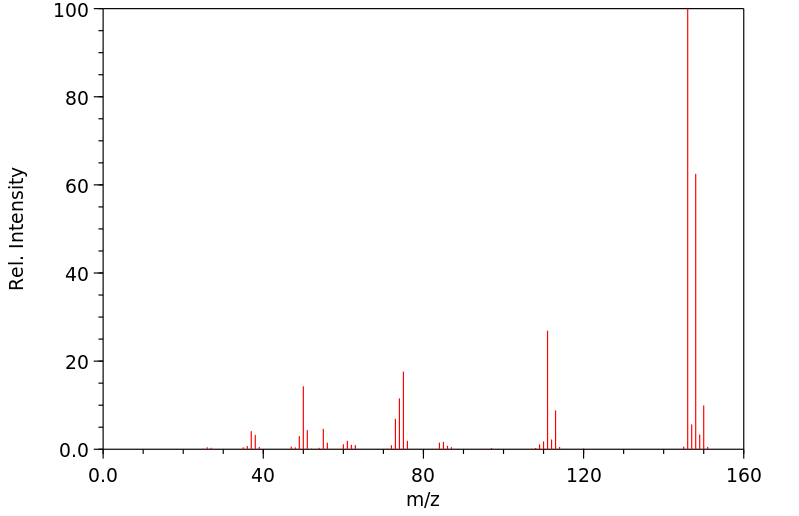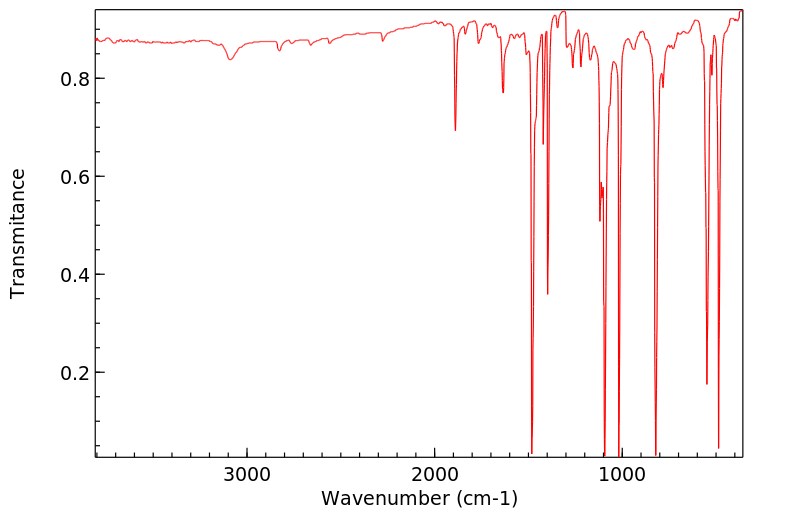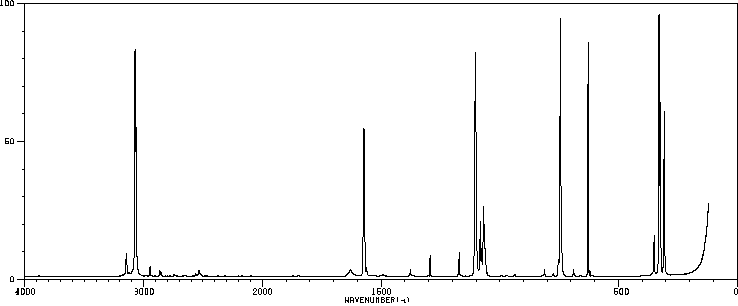1,4-二氯苯 | 106-46-7
-
物化性质
-
计算性质
-
ADMET
-
安全信息
-
SDS
-
制备方法与用途
-
上下游信息
-
文献信息
-
表征谱图
-
同类化合物
-
相关功能分类
-
相关结构分类
物化性质
-
熔点:52-54 °C (lit.)
-
沸点:173 °C (lit.)
-
密度:1.241 g/mL at 25 °C (lit.)
-
蒸气密度:5.07 (vs air)
-
闪点:150 °F
-
溶解度:水中的溶解度为0.08克/升
-
介电常数:2.8(53℃)
-
暴露限值:TLV-TWA 75 ppm (~450 mg/m3) (MSHA, OSHA, and NIOSH); IDLH 1000 ppm (NIOSH).
-
LogP:3.37 at 25℃ and pH7
-
物理描述:P-dichlorobenzene appears as a white colored liquid with the odor of moth balls. Denser than water and insoluble in water. Flash point below 200°F. Used as a moth repellent, to make other chemicals, as a fumigant, and for many other uses.
-
颜色/状态:White crystals
-
气味:Distinctive aromatic odor ... becomes very strong at concentrations between 30 and 60 ppm
-
蒸汽密度:5.08 (NTP, 1992) (Relative to Air)
-
蒸汽压力:1.74 mm Hg at 25 °C
-
亨利常数:0.00 atm-m3/mole
-
大气OH速率常数:3.20e-13 cm3/molecule*sec
-
稳定性/保质期:
Stable under recommended storage conditions.
-
自燃温度:No autoflammability up to 500 °C.
-
分解:Hazardous decomposition products formed under fire conditions - Carbon oxides, hydrogen chloride gas.
-
粘度:0.839 mPa.s at 55 °C; 0.668 mPa.s at 79 °C
-
腐蚀性:Non-corrosive
-
汽化热:49.0 kJ/mol at 25 °C
-
表面张力:31.4 dynes/cm
-
电离电位:8.98 eV
-
保留指数:991.21;990.6;989.5;1009;1014;991;996;987;1024;1016;1012;993;970;1016;1015;1016;970;1000;1057;970;1009.7;990;1004;1004;990.7;1002;989;1009;986;988;960;970;974;987;996.7;1011.1;1000;985;985;988;995;994;1023;1010;163.15;164.81
计算性质
-
辛醇/水分配系数(LogP):3.4
-
重原子数:8
-
可旋转键数:0
-
环数:1.0
-
sp3杂化的碳原子比例:0.0
-
拓扑面积:0
-
氢给体数:0
-
氢受体数:0
ADMET
安全信息
-
TSCA:Yes
-
危险等级:9
-
立即威胁生命和健康浓度:150 ppm
-
危险品标志:Xn
-
安全说明:S16,S36/37,S45,S46,S60,S61,S7
-
危险类别码:R36,R50/53,R40
-
WGK Germany:2
-
海关编码:2903919010
-
危险品运输编号:UN 3077 9/PG 3
-
危险类别:9
-
RTECS号:CZ4550000
-
包装等级:III
SDS
制备方法与用途
化学性质
白色结晶,具有刺激性气味。不溶于水,但可溶于乙醇、乙醚、苯等多种有机溶剂。
用途
用于合成大红色基GG、活性嫩黄等染料;用作农药中间体、熏蒸杀虫剂、织物防蛀剂,并应用于有机合成中。
用途
作为有机分析试剂和溶剂,同时也用作杀虫、防蛀剂。对二氯苯是杀螟威(一种杀虫剂)、麦草畏(除草剂)及喹禾灵的中间体,也是染料与医药中间体,并可用于家庭用杀虫剂和防蛀剂。
用途
作为有机合成原料,用于合成染料(如大红色基GG、3GL红色基以及活性嫩黄和红色RC),并作为农药中间体。此外,还可用作熏蒸杀虫剂、织物防蛀剂、防霉剂及空气脱臭剂;65%至70%的对二氯苯用于制造卫生球,少量用于特压润滑剂、腐蚀抑制剂。该品也可应用于医药领域,并作为溶剂。
用途
广泛用于皮革防腐、农药和有机合成等方面。
用途
用作杀虫剂熏蒸剂、防蛀剂、除臭剂、防腐剂以及分析试剂等,且适用于有机合成。
生产方法
苯定向氯化或从氯苯生产中回收。1. 苯定向氯化:将苯置于氯化反应器中,加入0.1%-0.6%的硫化锑(Sb₂S)催化剂并通入氯气,在20℃左右控制温度下进行30-45分钟的氯化反应,随后加入苯磺酸定向催化剂,继续通入氯气直到二氯苯晶体析出。将反应液加热至50-60℃,缓慢通入氯气使反应液增重到理论量的95%左右,最后经过后处理、过滤和干燥得到产品,收率约为70%-75%。
生产方法
其制备方法有以下几种:
苯定向氯化:将苯置于氯化反应器中加入催化剂硫化锑(Sb₂S),开始通入氯气并控制氯化温度在20℃左右,在30-45分钟内完成氯化后,再加入苯磺酸定向催化剂继续通入氯气。当二氯苯晶体析出时,将反应液加热到50-60℃,缓慢通入氯气直到反应液增重达到理论量的95%左右,然后经过后处理、过滤和干燥得到产品。
生产方法
氯苯进一步氯化:以氯苯为原料与氯气在特定催化剂作用下定向氯化生产二氯苯(含对二氯苯、邻二氯苯及少量间二氯苯),结合高效填料塔精馏和立式结晶器进行结晶,得到高纯度的对二氯苯和邻二氯苯。过去也有通过从氯苯生产中的蒸馏残渣分离对二氯苯和邻二氯苯。
类别
易燃固体
毒性分级
中毒
急性毒性
口服:大鼠 LD50: 500 毫克/公斤;小鼠 LD50: 2950 毫克/公斤
刺激数据
眼:人接触80 PPM
爆炸物危险特性
与空气混合,受热或明火可爆
可燃性危险特性
遇明火、高温或氧化剂易燃;燃烧产生有毒氯化物烟雾
储运特性
库房应保持通风低温干燥,并与氧化剂分开存放
职业标准
TLV-TWA 75 PPM (450 毫克/立方米);STEL 110 PPM (675 毫克/立方米)
上下游信息
-
上游原料
中文名称 英文名称 CAS号 化学式 分子量 氯苯 chlorobenzene 108-90-7 C6H5Cl 112.559 1,3-二氯苯 1,3-Dichlorobenzene 541-73-1 C6H4Cl2 147.004 邻二氯苯 1,2-dichloro-benzene 95-50-1 C6H4Cl2 147.004 1,2,4,5-四氯苯 1,2,4,5-tetrachlorobenzene 95-94-3 C6H2Cl4 215.894 三氯苯 1,2,4-Trichlorobenzene 120-82-1 C6H3Cl3 181.449 1,2,3,5-四氯苯 1,2,3,5-tetrachlorobenzene 634-90-2 C6H2Cl4 215.894 1,2,3,4-四氯苯 1,2,3,4,-tetrachlorobenzene 634-66-2 C6H2Cl4 215.894 六氯苯 hexachlorobenzene 118-74-1 C6Cl6 284.784 五氯苯 pentachlorobenzene 608-93-5 C6HCl5 250.339 -
下游产品
中文名称 英文名称 CAS号 化学式 分子量 氯苯 chlorobenzene 108-90-7 C6H5Cl 112.559 1,3-二氯苯 1,3-Dichlorobenzene 541-73-1 C6H4Cl2 147.004 1,3,5-三氯苯 1,3,5-trichlorobenzene 108-70-3 C6H3Cl3 181.449 邻二氯苯 1,2-dichloro-benzene 95-50-1 C6H4Cl2 147.004 三氯苯 1,2,4-Trichlorobenzene 120-82-1 C6H3Cl3 181.449 1,2,4,5-四氯苯 1,2,4,5-tetrachlorobenzene 95-94-3 C6H2Cl4 215.894 1,2,3,5-四氯苯 1,2,3,5-tetrachlorobenzene 634-90-2 C6H2Cl4 215.894 六氯苯 hexachlorobenzene 118-74-1 C6Cl6 284.784
反应信息
-
作为反应物:参考文献:名称:含钯纳米金刚石存在下卤代苯的液相加氢摘要:摘要在温和条件下,在单卤苯(氯苯,溴苯和碘苯)与二氯苯的邻,间和对异构体的液相加氢脱卤的模型反应中,研究了含钯纳米金刚石(Pd / ND)的催化活性。 (Т = 45°С,\({{P} _ {{{{{ = 1个大气压)。将所得结果与相同条件下含钯活性炭(Pd / C)的催化性能进行比较。发现催化剂Pd / ND比Pd / C更具活性,并且对于反应过程中卤化氢形成的毒性作用更稳定。对HCl和NaOH添加剂对催化剂活性的影响的研究表明,在HCl的存在下,会发生催化剂中毒:反应速率降低;反应速率降低。在NaOH的存在下,催化剂活性增加;由于用碱将氯化氢中和,反应速率增加。对于两种催化剂,对于单卤代苯,反应速率按顺序Cl> Br> I降低;对于二氯苯,按顺序对->邻->间异构体降低。DOI:10.1134/s0965544118140049
-
作为产物:参考文献:名称:甘氨酸铜(II)配合物是芳基和杂芳基溴化物向氯化物的芳族Finkelstein反应的有效多相催化剂摘要:由氯化铜和甘氨酸轻松合成的甘氨酸铜(II)配合物1通过多种技术进行了表征,包括FTIR,XRD,TGA和SEM分析。发现合成后的铜络合物是通过芳基和杂芳基溴化物的芳族Finkelstein反应以高到极好的产率合成芳基和杂芳基氯化物的简单有效的催化剂。所开发的糖基铜(II)催化剂可轻松地从反应混合物中回收并成功重复使用数次,而不会降低催化效率。所开发的方法代表了使用非均相催化剂通过芳族Finkelstein反应合成芳基和杂芳基氯化物的第一个实例。DOI:10.1016/j.apcata.2013.12.022
-
作为试剂:描述:参考文献:名称:Willstaedt; Michaelis, Svensk Kemisk Tidskrift, 1938, vol. 50, p. 274,276摘要:DOI:
文献信息
-
一种氯代硫蒽酮的合成新方法申请人:宁波海曙琼杰化工技术研发工作室公开号:CN111763195A公开(公告)日:2020-10-13本发明公开了一种氯代硫蒽酮的合成新方法,属于化工技术领域。该方法包括如下步骤:首先将硫氢化钠溶液加入到硫化氢发生器中,再向硫化氢发生器中滴加酸,产生的气体被导入至预热后的管道反应器中;然后向管道反应器中泵入预热后的对二氯苯,对二氯苯与硫化氢气体发生反应,将反应产物冷却后得到液体和气体,液体经精馏提纯得巯基氯苯;其次,向烧瓶中加入反应溶剂和碱,搅拌,再加入巯基氯苯和邻氯苯甲酸进行回流反应,反应结束后经后处理得中间体2‑羧基‑4’‑氯二苯硫醚;最后将2‑羧基‑4’‑氯二苯硫醚加入至浓硫酸中进行分子内环合脱水反应,反应结束后经提纯得目标产品。本发明方法操作简便、反应条件温和、清洁环保,产品收率和纯度高。
-
[EN] BICYCLYL-SUBSTITUTED ISOTHIAZOLINE COMPOUNDS<br/>[FR] COMPOSÉS ISOTHIAZOLINE SUBSTITUÉS PAR UN BICYCLYLE申请人:BASF SE公开号:WO2014206910A1公开(公告)日:2014-12-31The present invention relates to bicyclyl-substituted isothiazoline compounds of formula (I) wherein the variables are as defined in the claims and description. The compounds are useful for combating or controlling invertebrate pests, in particular arthropod pests and nematodes. The invention also relates to a method for controlling invertebrate pests by using these compounds and to plant propagation material and to an agricultural and a veterinary composition comprising said compounds.本发明涉及公式(I)中变量如索权和说明中所定义的自行车基取代异噻唑啉化合物。这些化合物对抗或控制无脊椎动物害虫,特别是节肢动物害虫和线虫方面具有用途。该发明还涉及一种通过使用这些化合物来控制无脊椎动物害虫的方法,以及包含所述化合物的植物繁殖材料、农业和兽医组合物。
-
Preparation of 3-alkoxy-2-methylbenzoic acids
-
[EN] MICROBIOCIDAL OXADIAZOLE DERIVATIVES<br/>[FR] DÉRIVÉS D'OXADIAZOLE MICROBIOCIDES申请人:SYNGENTA PARTICIPATIONS AG公开号:WO2017157962A1公开(公告)日:2017-09-21Compounds of the formula (I) wherein the substituents are as defined in claim 1, useful as a pesticides, especially fungicides.式(I)的化合物,其中取代基如权利要求1所定义,作为杀虫剂特别是杀菌剂有用。
-
Thieno-pyrimidine compounds having fungicidal activity
表征谱图
-
氢谱1HNMR
-
质谱MS
-
碳谱13CNMR
-
红外IR
-
拉曼Raman
-
峰位数据
-
峰位匹配
-
表征信息











